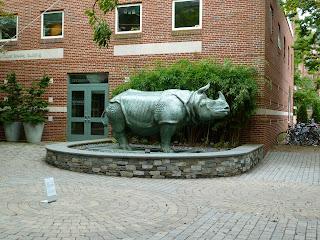Imagine a globe so big you can walk through it, a globe that is three stories high providing you with a view from inside its center. There is such a globe in Boston. You walk to the center on a glass bridge and the globe surrounds you. How such a globe was built is an interesting story.
Chester Lindsay Churchill, a Boston architect, designed the globe, called the Mapparium. Artists then traced a map of the world onto thick glass panels. Using a colored powdered glass mixture each panel was painted and then fired in a kiln to fuse the color to the glass. Kiln temperatures ranged from 1,000 to 1,350 degrees Fahrenheit. When completed there were 608 glass panels to install into a spherical bronze frame. The finished globe is the only one in the world visitors can walk through. The scale of the map is 1” = 22 miles.
Sound inside the Mapparium is surprising to visitors. Because the globe is spherical in shape, the glass creates an unusual acoustical property. When you speak aloud, it sounds as if you are talking into your own ears. And, there is what is called the whispering gallery effect. If two people stand on opposite ends of the bridge and whisper to each other, even though they are far apart, each can hear the other as if the two were standing side by side.
Today there are almost 200 countries in the world where 6,800 different languages are spoken. But did you know that the map of the world continues to change? Why do you think this happens? Since 1990 more than thirty countries have been added. The newest country is South Sudan, which seceded from Sudan in July 2011. If you look at the giant globe in the Mapparium, you will notice that the globe was very different in 1935 from what it is today. Sri Lanka was called Ceylon and Belize was known as British Honduras. Many of the African countries had very different names in 1935. Why do countries change their names? Since 1935, what countries have changed their names? You can find a 1935 world map on the Internet and compare it to a map of today. See how many countries you can find that have changed there names and also how many countries exist today that did not exist in 1935 when the Mapparium globe was created.
 |
| Boston Museum of Fine Arts logo |
 |
| This sculpture of a man walking across a beam can be found in the Boston Museum of Fine Art parking lot. |
It is always exciting to see the originals of famous works of art. All of my life I have seen the two paintings below in various books I have read. Perhaps you have seen them, too. Both paintings are very famous and are of men you have learned about. When you see paintings in real life, you can see the artist's brush strokes and the play of light and shadow as well as the artist's use of color. In books, the paintings can appear flat and dull.
Who is this fellow? A big clue is the silver object he is holding. This man was a Colonial silversmith named Paul Revere. John Singleton Copley, a famous Boston artist, painted this portrait in 1768. You can read more about Copley on the Internet.
This is another portrait by Copley--John Hancock. Both of these paintings hang in the Boston Museum of Fine Art.
 |
| The interior courtyard of the Isabella Stewart Gardener Museum has a glass ceiling. |
 |
| These fellows greet you at the Isabella Stewart Gardener Museum. |
Would you like to be an artist? If studying art interests you, consider attending the School of the Museum of Fine Arts in Boston. It is situated in the same neighborhood as the MFA and the Gardener Museum. Outside sits the sculpture of a rhinoceros shown in the photograph below.
Student artwork is on display in the school. I liked this cartoon and took a photograph of it because I think it gives good advice: STAY IN SCHOOL.
 |
| A student cartoon. (Can you find the mistake?) |






No comments:
Post a Comment